 Swamp Gas May Be Used in New Diabetes Treatments: Hydrogen sulfide, more commonly known as “swamp gas” – is responsible for various disagreeable odors, from the smell of rotting plants and sewer systems to certain industrial fumes. Yet a new study supported by the National Institutes of Health, the Juvenile Diabetes Foundation, and Shriners Hospital for Children and conducted by the University of Texas Medical Branch at Galveston suggests that this foul-smelling compound plays an important role in shielding blood vessels from the effects of diabetes.
Swamp Gas May Be Used in New Diabetes Treatments: Hydrogen sulfide, more commonly known as “swamp gas” – is responsible for various disagreeable odors, from the smell of rotting plants and sewer systems to certain industrial fumes. Yet a new study supported by the National Institutes of Health, the Juvenile Diabetes Foundation, and Shriners Hospital for Children and conducted by the University of Texas Medical Branch at Galveston suggests that this foul-smelling compound plays an important role in shielding blood vessels from the effects of diabetes.
The University of Texas Medical Branch states in a new paper published in the Proceedings of the National Academy of Science that experiments with diabetic rats and human endothelial cells – the cells that make up the inside layer of our blood vessels – have shown that hydrogen sulfide levels play an important role in the possibility of diabetic complications in the blood vessels. It has been shown in recent years that hydrogen sulfide occurs naturally in the human body, playing a role in the circulatory system.
The UTMB research group, headed by Dr. Csaba Szabo, began their experiments by exposing human endothelial cells to sugar at a level similar to what the cells of a diabetic person would experience. The results were predictable: “Upon exposure to such high sugar levels, the cells started to produce increasing amounts of highly reactive toxic free radicals, and as a consequence, they began to die,” Dr. Szabo stated. However, the presence of hydrogen sulfide affected the health of the endothelial cells: “Low hydrogen sulfide levels accelerated this process, while constant replacement of hydrogen sulfide protected the cells against the toxic effects of high sugar,” according to Dr. Szabo. Exposing the cells to this “swamp gas” was shown to have a protective effect against the complications of diabetes.
In treating diabetic rats, the research team showed that these rats had lower levels of hydrogen sulfide present in their circulatory systems than normal. They also improved the rats’ conditions by exposing them to hydrogen sulfide treatment for a month, improving the health of their blood vessels.
Dr. Szabo stressed the importance of the health of the endothelial cells in preventing diabetic complications. “The loss of endothelial cell function in diabetes is a first step that leads to many complications, such as eye disease, heart disease, kidney disease, foot disease and others.” He went on to state that this swamp gas research may be utilized in new diabetes treatments: “The observation that hydrogen sulfide can control an early checkpoint in all of these processes may open the door for new therapies.”
 Body Muscle Mass Helps Fight
Body Muscle Mass Helps Fight  New Research – Stem Cell Memory and
New Research – Stem Cell Memory and  Cell Phones Helping Manage Diabetes: According to a new study from the University Of Maryland School Of Medicine, an interactive computer software program could be very effective in helping patients with type 2 diabetes, manage their diabetes using their mobile phone.
Cell Phones Helping Manage Diabetes: According to a new study from the University Of Maryland School Of Medicine, an interactive computer software program could be very effective in helping patients with type 2 diabetes, manage their diabetes using their mobile phone. No Higher Risk for Type 2 Diabetes In Natural Menopause versus Ovarian Removal Menopause: Whether menopause comes naturally as a female ages or is brought on at an earlier age due to a hysterectomy that involves ovary removal, there is no increase in the diagnosis of type 2 diabetes, and the risk for type 2 diabetes does not increase.
No Higher Risk for Type 2 Diabetes In Natural Menopause versus Ovarian Removal Menopause: Whether menopause comes naturally as a female ages or is brought on at an earlier age due to a hysterectomy that involves ovary removal, there is no increase in the diagnosis of type 2 diabetes, and the risk for type 2 diabetes does not increase.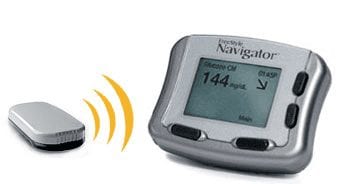
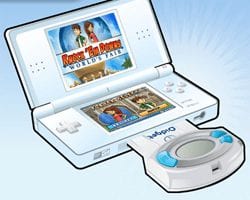 Bayer Didget Meter For Kids: Children get diabetes just like adults. In fact, studies suggest that more children are developing diabetes a lot earlier on. According to the American Diabetes Association, about 215,000 children and adolescents under that age of 20 have either type 1 or type 2 diabetes and one in every four hundred children have type 1 diabetes.
Bayer Didget Meter For Kids: Children get diabetes just like adults. In fact, studies suggest that more children are developing diabetes a lot earlier on. According to the American Diabetes Association, about 215,000 children and adolescents under that age of 20 have either type 1 or type 2 diabetes and one in every four hundred children have type 1 diabetes.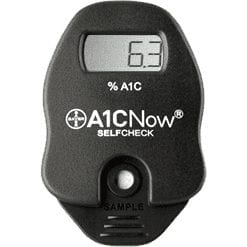 Bayer
Bayer 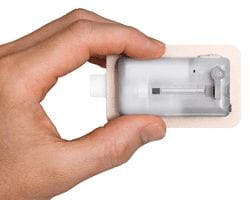 V-Go Disposable
V-Go Disposable 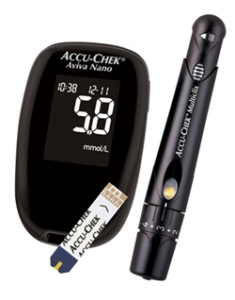 Accu-Chek Aviva Nano: Monitoring your blood sugar levels is very important and when a diabetic patient is unable to check their blood sugar, it can cause some other health issues such as retinopathy or
Accu-Chek Aviva Nano: Monitoring your blood sugar levels is very important and when a diabetic patient is unable to check their blood sugar, it can cause some other health issues such as retinopathy or